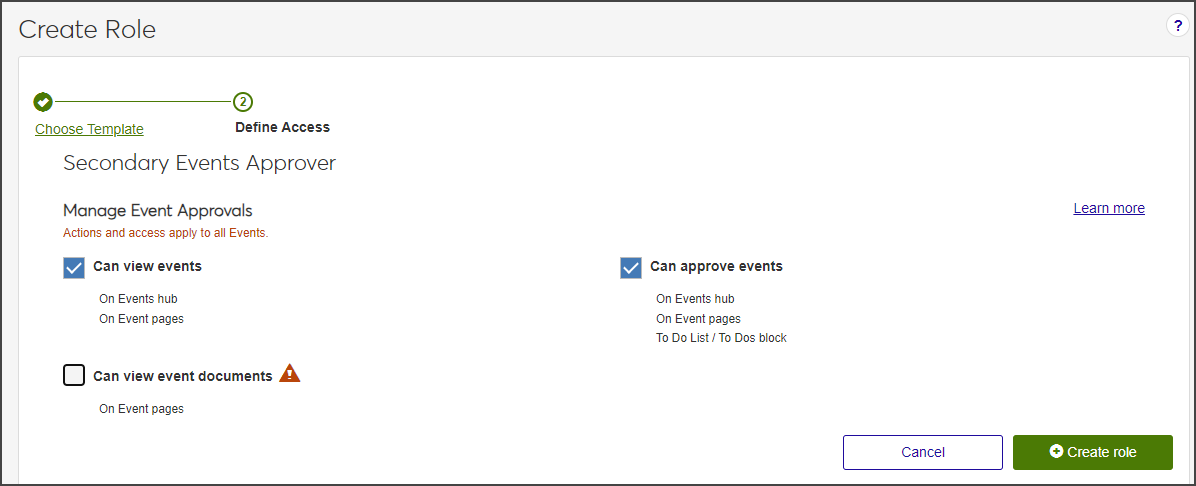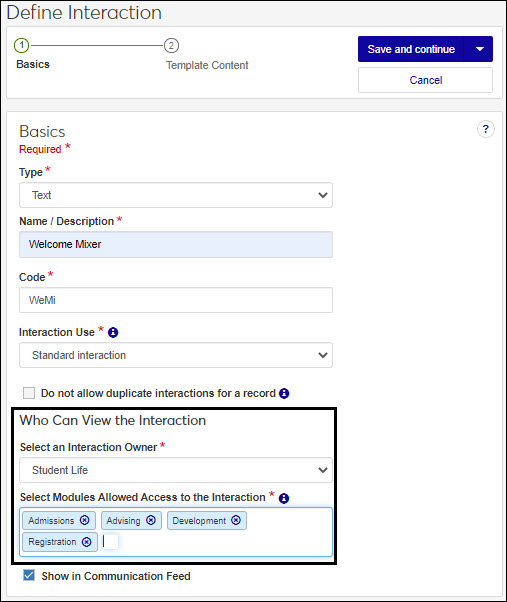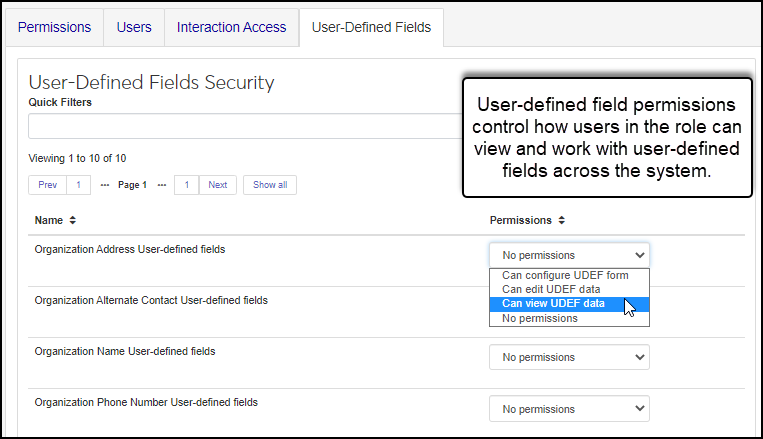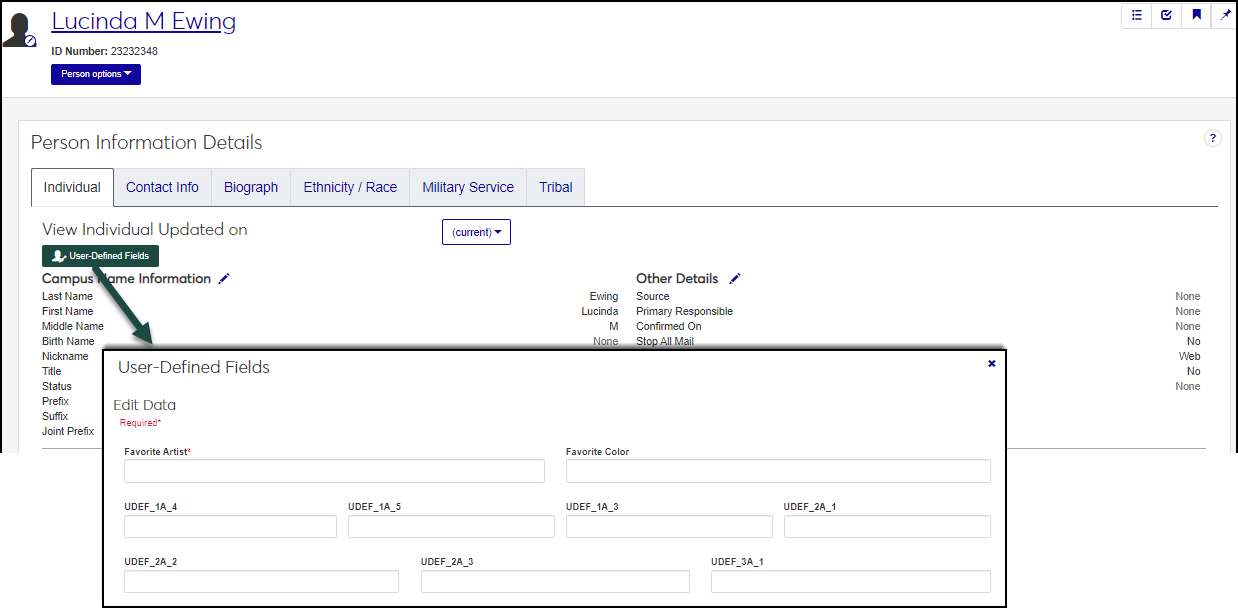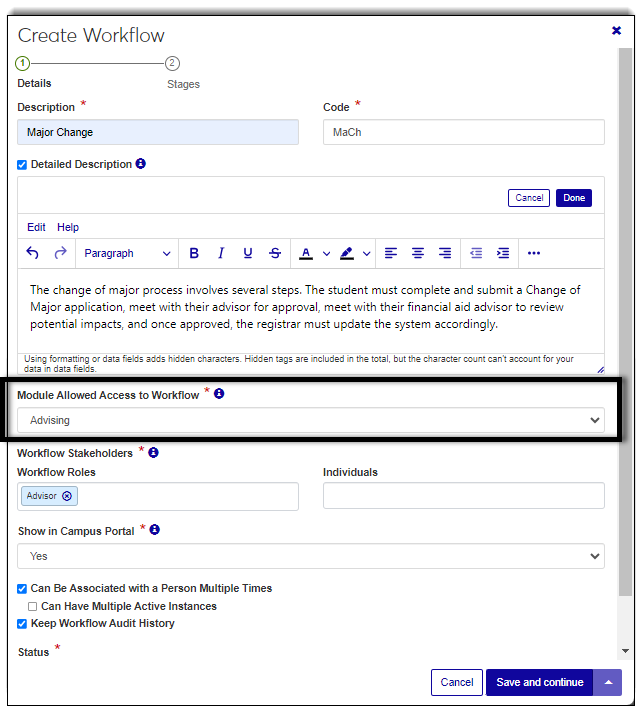Workflow Roles and Permissions
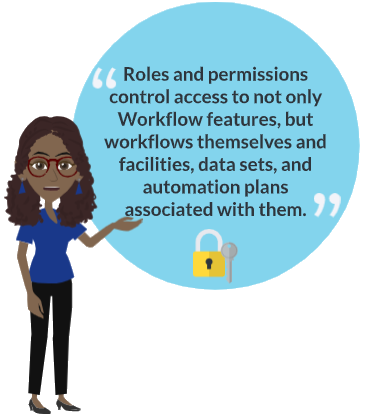
Roles determine what users can and cannot do in J1 Web. Each role has specific privileges to different features and information available to those users assigned to it. Jenzabar provides standardized 'default roles' for each module. Use these default roles as templates that can be copied and tailored to create new roles with varying permissions to control different levels of access. For example, you can set roles up according to your school's organizational or departmental hierarchy. Roles can have multiple users assigned to them and a user can belong to multiple roles.
Standard roles are provided by Jenzabar and control access to common and module-specific features. All users belong to the J1 Web User role that allows access to basic Web features.
Workflow Roles and Permissions
The following table shows the permissions available for the Workflow roles.
Permission | Base | Plus |
|---|---|---|
Can manage workflow definitions |  | |
Can view workflows |  | |
Can associate workflows |  | |
Can delete workflows |  | |
Can remove workflows |  | |
Can automate long running processes |  | |
Can add or edit automation plans |  | |
Can delete automation plans |  | |
Can view automation plans |  | |
Can manually run automation plans |  | |
Can manage blocks |  | |
Can request Third Party Signatures |  | |
Can view object workflows |  |
Workflow Base Permissions
Workflow Base
The default Workflow Base role determines which users can access and work with different workflows and automation plans.
J1 Web users do not need to be in a Workflow role to be involved with a workflow. For general purposes, users only need to be in a role with Interaction Access permissions enabled.
Definitions
Permission | Users in this role can. . . |
|---|---|
Can manage workflow definitions | Create, update, publish, associate, and delete workflows on the Manage Workflows page. |
Workflows
Permission | Users in this role can. . . |
|---|---|
Can view workflows | View workflows on person pages. General system users that aren't responsible for managing workflows do not need this permission to see workflows. General users only need to be in a role with module access enabled. |
Can associate workflows | Associate workflows with individuals from their pages in the system. |
Can delete workflows | Delete inactive, unused interactions on the Manage Workflows page. |
Can remove workflows | Remove a workflow associated with an individual. |
Automation Plan Permissions
Permission | Users in this role can. . . |
|---|---|
Can automate long running processes | Long running processes can be initiated from automation plans. Long running processes can be performing rules-based updates, making automated advisor assignments, and stored procedures. Users with this permission enabled can include a long running process in the automation plan they create. |
Can add or edit automation plans | Build and manage automation plans. |
Can delete automation plans | Permanently delete automation plans in J1 Web. These users should understand when and how automation plans are used. |
Can view automation plans | View automation plans and the interactions associated with them. |
Can manually run automation plans | Access Run Automation Plan Now option to run an automation plan outside the scheduled timeframe. |
Additional Permissions
Permission | Users in this role can. . . |
|---|---|
Can manage blocks | Access block settings on the Workflow Summary page. These settings let users add and update custom content blocks as well as remove, activate, deactivate, and reorder Jenzabar-provide and custom content blocks on the page. |
Workflow Licensed Permissions
The default Workflow Licensed role is available with the licensed Plus version of Workflow and grants access to options for requesting third party signature from DocuSign and lets users see workflows associated with objects in the system.
Permission | Users in this role can. . . |
|---|---|
Can request Third Party signatures | Lets users creating workflows request a DocuSign signature on uploaded forms. |
Can view object workflows | View workflows on object pages. For example, when a workflow is associated with a facility. |
Recommended Workflow Roles
Not all J1 Web users participating in workflows need to be assigned to a Workflow role or have permission to access different workflows. Users that only need to review, approve, and deny workflow items assigned to them will be able to do so from their To Do list, which is available to everyone from their Home page as well as the global icons at the top of every page.
Jenzabar recommends copying the Workflow Base and Licensed default roles to create the following custom Workflow roles:
Role | Responsibilities | Example | |
|---|---|---|---|
Workflow Administrator  | Administrators have a comprehensive understanding of the various processes and steps needed to complete them in their area.
*Workflow Plus only. | Registrars and Department Heads | |
Workflow Manager  | Managers know who should be assigned to different processes and monitor them to ensure progress. They are also occasionally responsible for completing various tasks.
| Advisor | |
Workflow Stakeholder  | Stakeholders monitor workflow progress and associate workflows with individuals.
| Athletics Coach, Financial Aid Officer, Student Success Officer | |
Workflow User
| Workflow users have limited access requirements. They view workflows associated with individuals and report on workflow progress, but they do not participate in them or manage who they are assigned to.
| Administrative Support, Student Support |
Common Roles and Permissions for Workflow Users
To fully leverage Workflow features, users may need to be assigned one or more of the following common roles:
All users that work in J1 Web are assigned to the J1 Web User role, which grants permissions to standard features like bookmarks, calendar, to do lists, and pins. There are different ways to assign people to this role that depend on your authentication method. For additional information, see Manage User Access to J1 Web.
To work with person and organization information, users must belong to one or more of the following roles. These roles let you see name and contact information for people/organizations:
Person Management
Organization Management
External Person Management
External Organization Management
Note
These are the default Jenzabar-provided roles. Your school should have created custom versions with unique names.
To ensure users who are able to search for or access certain people's information (e.g., high level donors or board members), assign them to a J1 Web Privacy role and define which users they won't be able to access in the system.
Associate Workflow users with the appropriate Facilities roles.
To associate workflows with facilities, Workflow Plus users must be in a Facilities User role with "Can view" permissions.
To view facilities associated with workflows, Workflow Base users need to be in a Facilities User role with "Can view" permissions enabled.
If a Workflow Administrator will be responsible for creating/managing interactions included in workflow-initiated automation plans, they must also belong to Communication Management Base and Communication Management Licensed roles. These roles allow them to:
View and access the Interaction Inventory and Interaction Inbox* to see communications sent and received (including historical Notepad messages).
Create and edit interaction templates that can be added to automation plans initiated from workflow item rules.*
*Plus only.
If a Workflow Administrator will be responsible for creating/managing data sets used with workflows, they must belong to Campus-wide Definitions role with data set permissions enabled. Data sets can be used with workflows to establish data requirements associated with a workflow, determine who a workflow is associated with, who will be assigned a specific workflow To Do.
Create Roles
Important
Information and features vary according to the roles to which you belong and the permissions associated with those roles. For more information, contact your module manager or your campus support team.
The Create Role process has five main steps:
Select the default role you want to base the new role on. The default role you select determines what features can be enabled. For example, the features available to be enabled for an Advising Administrator will differ from those for an Events Coordinator.
Update the role name and description to eliminate confusion with the original role.
Select the features and information that users assigned to the role will be able to access. You can also enable/disable features after the role has been created.
Assign users to the new role using the Edit Role and Manage System Users features.
Enable interaction access codes to determine which interactions and workflows this user can work with.
For roles that grant access to constituents and information through group associations, grant access to the appropriate groups. This step impacts the Department Head - Course Access role in Registration and all the Secondary Advisor roles in Advising.
It is recommended to use a role name that most administrative users will easily understand. For example, you can base role names off of your organizational hierarchy to quickly distinguish permissions.
It is recommended to tailor the new role description by briefly describing the role. This can be particularly helpful in distinguishing multiple roles with similar permissions.
Click the Create role button. The Create Role page appears.
From the Role Template drop-down options, select the role template you want to base the new role on. The New Role Name and New Role Description fields automatically fill with the name and description of the original role template.
In the New Role Name field, update the role name to an easily recognizable name. The name can be based on how roles and positions are set up at your school and should distinguish how this role differs from the role template.
In the New Role Description field, update the description to highlight permissions or features available to users assigned to the role. The description can help distinguish how the new role differs from the role template.
Click Save and continue to move to the Define Access step.
Select the checkboxes of the permissions you want to enable for this role.
Click Create role. The Create Role page closes.
To assign users to the new role:
Select Edit from the Options drop-down next to the role you just created. The Edit Role page opens.
Select the Users tab.
Click Add to Role. The Add to Role pop-up opens.
In the Search Users by Name field, start typing the name of the user to be added to the role and select from the names that appear.
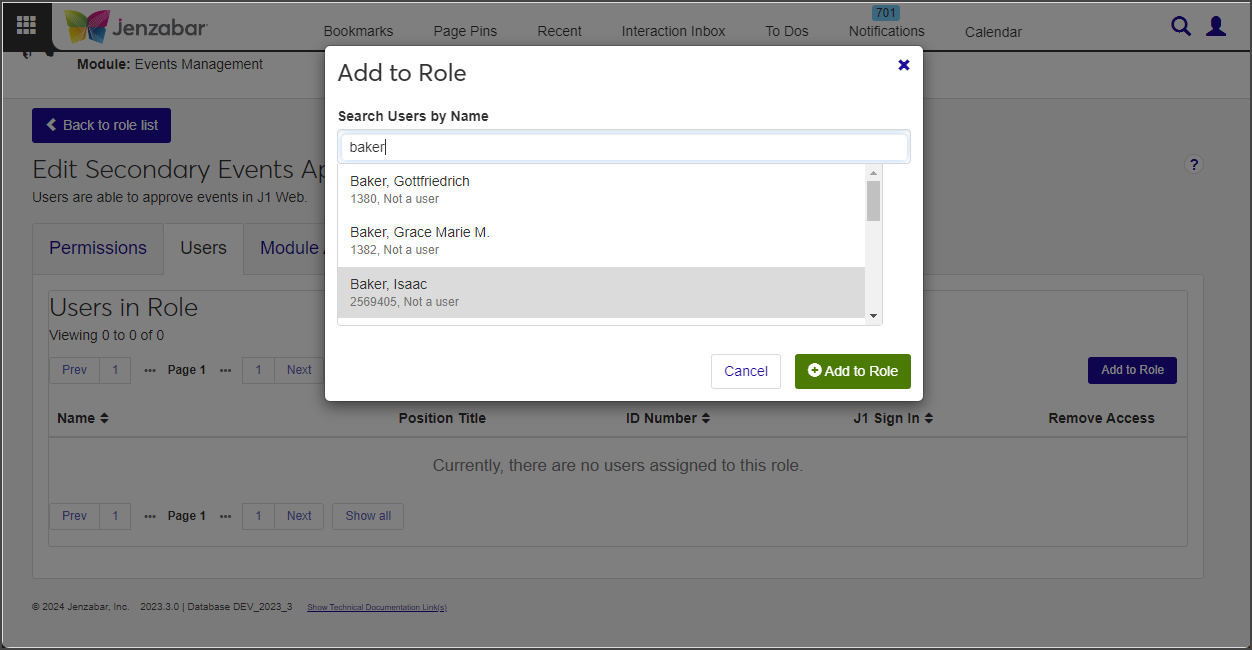
Repeat step d as many times as needed.
Click Add to Role. The Add to Role window closes. The users are added to the role and immediately have access to the information and features associated with it.
To manage access to interactions and workflows:
Module Access codes are loosely based on Desktop's Module Code Stamp. They control who can work with different interactions and workflows. Codes are associated with interactions and workflows when they're defined and created. J1 Web roles can have multiple access codes enabled and users that belong to multiple roles will have access to the interaction codes available with each.
Select Edit from the Options drop-down for the new role. The Edit Role page opens.
Select the Module Access tab.
From the Access column, click No or Yes as appropriate to prohibit or grant access to the interactions associated with that module.
To manage associations:
This option applies only to some roles, including Department Head Course Access (Registration), Secondary Advisor (Advising), Student Conduct - Assistant Director Access by Department (Student Life), Student Conduct - Director Access by Department (Student Life), and Student Activities User by Activity (Student Life).
The additional Associations tab lets you control access to constituents and information in the system based on the user's relationship to them. For example, you can enable access to selected majors so advisors with those majors enabled can see students assigned to them. If a student changes to a major that is not enabled for the role, the department head will lose access to their information.
Select Edit from the Options drop-down. The Edit Role page opens.
Select the Associations tab.
From the group drop-down, select the student or course group you want to enable access to. The groups appear.
Notice
For example, the Secondary Advisor - Access to Students by Academic Program role has students grouped by certifications, concentrations, minors, and programs. When you select the certifications group, you see a list of available certifications and can enable access to the appropriate ones.
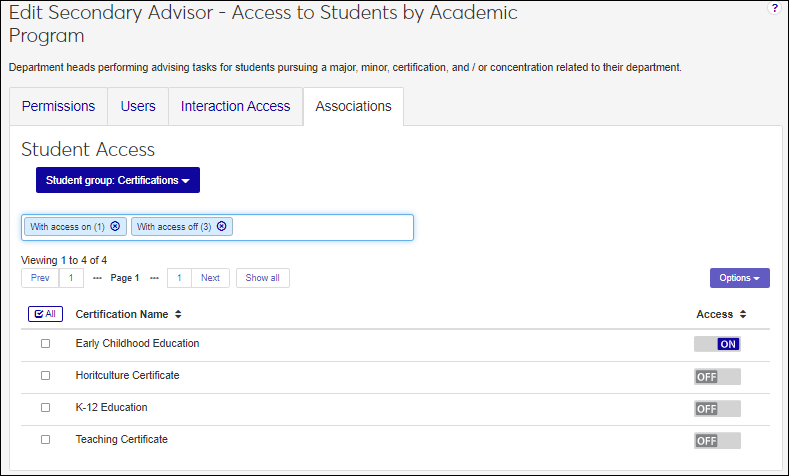
From the Access column, click Off or On to disable or enable access to the appropriate groups. Users assigned to the role will have access to constituents or information based on their association to them.
To manage access to user-defined fields:
Select the User-Defined Fields tab.
In the row for the user-defined fields you want to grant or restrict access to, in the Permissions column:
Select No permissions (default) to restrict users from accessing user-defined fields.
Select Can view UDEF data to allow users to view data only. They will not be able to edit or enter data.
Select Can edit UDEF data to allow users to enter data in user-defined fields.
Select Can configure UDEF data to allow users to design the user-designed field forms (this option grants view and edit permissions as well).
When creating a new role, it starts as an unmodified default role template provided by Jenzabar, with no permissions altered. You will need to customize the role by selecting the permissions you want to grant.
When copying a role, you can base it on either a default role or a custom role that you previously created and customized. The new role automatically inherits the permissions of the original role.
Note
In either case, copied or created, only the permissions are inherited. No users are copied over with the new role.
Only Jenzabar-provided roles are available to be used as a template in the create role process. If you want to create a new role based on a role you have customized or created, use the Copy role feature from the System Roles page.
The role template is provided by Jenzabar and cannot be modified. This helps ensure the base template can easily be identified by other administrative users when creating roles. You can tailor the name of the role being creating using the New Role Name field.
Edit Role
Important
Information and features vary according to the roles to which you belong and the permissions associated with those roles. For more information, contact your module manager or your campus support team.
The Edit Role page lets you view the users associated with a role, manage the permissions associated with a role, and add and remove users to and from roles. You can choose to view version indicators to see what roles have been added or changed in a specific release or for all releases. This helps identify new permissions and ensure they are enabled for the appropriate roles.
Note
Users assigned to a role are notified when permissions are removed from the role or if the role is deleted.
Use this tab to enable and disable the different permissions available with the role.
Use this tab to see a list of the users assigned to this role.
Name
Click a user's name to access their page
Click the + icon to view other roles the user is associated with
Position Title shows any titles a user is assigned to on the Desktop HR Employee Master via Personnel window, Positions tab. If the user is not assigned to a position title, nothing appears in this column.
ID Number
J1 Sign In shows the user's J1 ID managed in the Desktop (Users window)
Remove Access provides a remove button you can use to remove the user from the role
Use this tab to enable/disable access to different interactions and workflows. Codes are associated with interactions and workflows when they are defined and created.
Jenzabar provides access codes based on Jenzabar modules and you can create custom ones on the Access Codes page. If a user belongs to multiple roles, they’ll have access to the interactions and workflows available with each.
Description identifies the access code. Jenzabar provides interaction codes based on modules.
Code system generated access code identifiers.
Access enables/disables users access to interactions and workflows associated with the module code. If the Registration access is enabled and then selected when creating interactions, users in a role with Registration access enabled will be able to view/work with the interaction. Consider what departments would benefit from seeing different interactions and workflows with students or staff. For example, registration users might benefit from being able to view/comment on advising interactions.
The Associations tab is only available for select roles and options vary by role. It lets you control access to constituents and information in the system based on the user's relationship to them.
Example: You can create a Department Head role and enable access to select majors. They'll be able to see students assigned to those enabled majors. When a student changes to a major that role doesn't have enabled, the department head will lose access to their information.
Example: You can create an advising role for your coaches and enable access to select athletic rosters. Coaches will gain and lose access to students as the students are added and removed from the rosters.
User-Defined Fields tab controls permissions for viewing, editing, and configuring user-defined fields (UDEF) across the system. Users that belong to multiple roles will have access to the user-defined features enabled with each.
Permission levels determine what users can do with user-defined fields:
No permissions means users in this role will not see user-defined fields in the system
Can configure UDEF form means users in this role can see user-defined fields in the system as well as manage the fields from the Manage User-Defined Fields page
Can view UDEF data means users in this role can see the user-defined fields in the system
Can edit UDEF data means users in this role can add, update, or delete data in the user-defined fields in the system
Access the Edit Role page, Permissions tab.
From the Permissions tab, click Edit. The permissions checkboxes become available.
Click Edit. Permission options are enabled.
Select the checkboxes of the permissions you want to grant the role or deselect the permissions you want to remove from the role.
Note
When assigning permissions to the role, it is important to consider the different levels of capability you want users to be granted. You may want to create several roles with varying permissions to accommodate different types of users.
Tip
To review detailed information about the role permissions, refer to Jenzabar-Provided Roles topic.
Click Save. Several things happen:
Permissions are associated with the role and the checkboxes are no longer enabled.
Role permissions are immediately applied. A user will immediately have permission granted or revoked according to the updated features of the role.
Impacted users are notified about any permissions that may have been removed in a J1 message and a notification banner on their Home page. These link to detailed information about the changes.
Access the Edit Role page, Users tab.
From the Users tab, click Add to role. The Add to role window appears.
To add individual users:
In the Search Users by Name field, start typing the name of the user to be added to the role.
From the user names that appear, select the user to be added to the role.
Note
If your school is licensed for HR and the user is associated with a position, it appears in the user list.
Note
Only active J1 Web users can be added to the role. Users are activated using the Desktop Users window. For more information, see Managing User Access to J1 Web.
Click the Add to role button. The user is added to the role and immediately has access to information and features associated with the role. Desktop and additional role information is available by clicking the Expand icon.
To grant access to multiple users in a group with secondary access:
Select the Associations tab.
From the Group drop-down options, select the appropriate group you want to grant access to. Available grouping appear. This may be departments or campus locations.
Turn the appropriate Access switches to ON or OFF.
Tip
To enable or disable multiple access options at the same time, select the appropriate checkboxes or the All checkbox. Then from the Options drop-down and select Turn access off or Turn access on.
Click Collapse details and repeat Step C to set up additional permissions as needed.
Access the Edit Role page, Users tab.
Locate the user to be removed from the role.
Note
To quickly find a user, type their name in the Filter these users field or sort the users by clicking on any of the column headings.
From the Remove Access column, click the Remove icon . The confirm remove pop-up window appears
Click Yes, remove. Several things happen:
The confirm remove pop-up window closes and the role permissions are immediately applied. The user will immediately no longer have permission to the features associated with the role.
The user no longer appears in the list of users in the role.
Impacted users receive a message to notify them they have been removed from the role and a notification banner on their Home page. These link to detailed information about the change.
Note
Users removed from a role still appear on any system messages and tasks they were a included with before being removed.
To view a user's Desktop ID Number and Sign In, and a list of any other roles the user is assigned to, click the Expand icon.
Note
Use the column headings to quickly sort the listings.
Module Access codes are loosely based on Desktop's Module Code Stamp. They control who can work with different interactions and workflows. Codes are associated with interactions and workflows when they're defined and created. J1 Web roles can have multiple access codes enabled and users that belong to multiple roles will have access to the interaction codes available with each.
Access the Edit Role page, Module Access tab.
From the Access column, click the No and Yes option to grant and prohibit access to the interaction and workflow codes. Consider which departments would benefit from seeing different interactions with students or staff. For example, registration users might benefit from being able to view/comment on advising interactions and workflows.
Access the Edit Role page, User-Defined Fields tab.
Find the user-defined fields you want to control access to using the search.
From the Permissions drop-down select from the following:
No permissions means users in this role will not see user-defined fields in the system
Can configure UDEF form means users in this role can see user-defined fields in the system as well as manage the fields from the Manage User-Defined Fields page
Can view UDEF data means users in this role can see the user-defined fields in the system
Can edit UDEF data means users in this role can add, update, or delete data in the user-defined fields in the system
The Associations tab is only available for select roles and options vary by role. Associations let you control access to constituents and information in the system based on the user's relationship to them.
Access the Edit Role page, Associations tab.
From the group drop-down, select the student or course group you want to enable access to. The groups appear.
Notice
For example, the Secondary Advisor - Access to Students by Academic Program role has student grouped by certifications, concentrations, minors, and programs. Once you select the certifications group, you'll see a list of the available certifications and can enable access to the appropriate ones.

From the Access column, click the OFF and ON option to enable and disable access to the appropriate groups. Users assigned to the role will have access to constituents or information based on their association to them.
From the Updates by Version drop-down, select the version you want to see information about new and updated roles for.
New and Updated indicators appear next to roles that were added or changed for the selected release version.
New means the role was added to J1 Web in the release shown.
Updated means the role was changed in the release shown. This could mean permissions were added or modified.
Note
Removed roles and permissions are not shown at this time.
Yes, click the Expand icon. The user's Desktop login, ID, and other J1 Web roles appear.
Yes, you can remove and grant access to the same user as many times as needed. Follow the How Tos listed above for step-by-step instructions on adding a user to a role and removing a user from a role.
Yes, any users assigned to a role can immediately access all the information and features associated with the role. You can create several similar roles with varying levels of access to control access for different users.
Ensure you clicked the Edit button before updating the role permissions. If you still cannot update the role permissions, you may not have access to the edit feature.
They may not have been added to the Desktop application. This can be verified using the Desktop Users window.
Users can be added in J1 Web if they are informally associated with a process, but they cannot log in to J1 Web and are not considered active J1 Web users. In order to be assigned to a role in J1 Web, they must be in the Desktop application and have an active J1 Web login (designated on the Desktop Users window).
Several things could cause this happen:
The user may be in the Desktop application, but doesn't have an active J1 Web login.
The user may have been added to J1 Web and not the Desktop application.
The user may be in the Desktop application, but doesn't have an active J1 Web login.
The user may already be assigned to this role.
To resolve this issue:
Verify the user exists on the Desktop Users window.
Verify the user has an active J1 Web login on the Desktop Users window.
Verify the user isn't already assigned to the role by searching for them in the Filter these users search option.
Position titles are assigned to users on the Desktop HR Employee Master via Personnel window, Positions tab. If the user is not assigned to a position title, nothing appears in this column.
Your school may not be licensed to use the Human Resources module.
The user may not be assigned to a position on the Desktop HR Employee Master via Personnel window, Positions tab.
When a permission is highlighted in yellow, it means it's not in its default state.
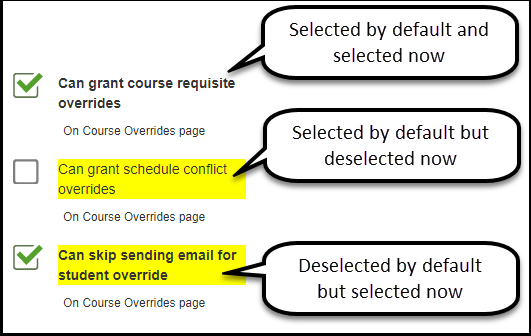 |
Some permissions are selected and can't be deselected because another permission depends on them. For example, granting course overrides depends on being able to view them. Therefore, you can't deselect the "Can view course overrides" permission if "Can grant course-full overrides" is selected.
Version indicators show you what roles have been added or changed and in what release. This can help you identify new permissions and ensure they are enabled for the appropriate roles.
Use the Updates by Version drop-down to select a specific version, all versions, or no versions.
New means the role was added to J1 Web in the release shown
Updated means the role was changed in the release shown. This could mean permissions were added or modified
Note
Removed roles and permissions are not shown at this time.
Jenzabar provides access codes based on Jenzabar modules; however, you can create custom ones using the Access Codes page (Core, Campus-wide Definitions, Access Codes).


